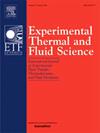A new method to measure hydrodynamic parameters of liquid–gas slug flow using ultrasound technique
IF 3.3
2区 工程技术
Q2 ENGINEERING, MECHANICAL
Experimental Thermal and Fluid Science
Pub Date : 2025-08-18
DOI:10.1016/j.expthermflusci.2025.111592
引用次数: 0
Abstract
The slug flow is a multiphase flow pattern widely found in many industries, like power generation, petrochemical, and oil and gas. Several experimental investigations have been done to estimate slug flow characteristics. Nevertheless, there is a lack of attention to assessing the gas velocity in the liquid slug and the evaluation of the applicability of the developed ultrasound techniques in media with different viscosity. In this context, this paper aims to show a new method, based only on ultrasound measurements, to estimate gas velocity in a liquid slug, Taylor bubble passage frequency, Taylor bubble length, and liquid slug length, as well as to analyze the effects of viscosity on slug flow characteristics assessed using ultrasound techniques. The experiments are carried out in a 2” vertical pipe with water–air or oil–air flows. The ultrasonic measurements were carried out using two piezoelectric transducers of 2.25 MHz central frequency in a pulse-echo mode. The raw echo signals acquired were processed to obtain the echo energy and time-of-flight signals to estimate the slug flow characteristics. The results indicate that the ultrasound method developed can estimate the slug flow characteristics in the water–air and oil–air two-phase flows.
一种利用超声技术测量液气段塞流流体动力参数的新方法
段塞流是一种多相流,广泛应用于发电、石化、油气等行业。为了估计段塞流特性,已经进行了一些实验研究。然而,对于液体段塞流中气体速度的评估以及所开发的超声技术在不同粘度介质中的适用性评估缺乏关注。在此背景下,本文旨在展示一种仅基于超声测量的新方法,以估计液体段塞流中的气体速度、泰勒气泡通过频率、泰勒气泡长度和液体段塞流长度,并分析粘度对使用超声技术评估的段塞流流动特性的影响。实验是在一个有水-空气或油-空气流动的2英寸垂直管道中进行的。在脉冲回波模式下,使用两个中心频率为2.25 MHz的压电换能器进行超声测量。对采集到的原始回波信号进行处理,得到回波能量和飞行时间信号,以估计段塞流特性。结果表明,所建立的超声方法可以准确地估计水-气和油-气两相流中的段塞流特性。
本文章由计算机程序翻译,如有差异,请以英文原文为准。
求助全文
约1分钟内获得全文
求助全文
来源期刊

Experimental Thermal and Fluid Science
工程技术-工程:机械
CiteScore
6.70
自引率
3.10%
发文量
159
审稿时长
34 days
期刊介绍:
Experimental Thermal and Fluid Science provides a forum for research emphasizing experimental work that enhances fundamental understanding of heat transfer, thermodynamics, and fluid mechanics. In addition to the principal areas of research, the journal covers research results in related fields, including combined heat and mass transfer, flows with phase transition, micro- and nano-scale systems, multiphase flow, combustion, radiative transfer, porous media, cryogenics, turbulence, and novel experimental techniques.
 求助内容:
求助内容: 应助结果提醒方式:
应助结果提醒方式:


